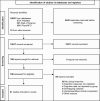Neuropsychological Performance Among Individuals at Clinical High-Risk for Psychosis vs Putatively Low-Risk Peers With Other Psychopathology: A Systematic Review and Meta-Analysis
- PMID: 35333372
- PMCID: PMC9434467
- DOI: 10.1093/schbul/sbac031
Neuropsychological Performance Among Individuals at Clinical High-Risk for Psychosis vs Putatively Low-Risk Peers With Other Psychopathology: A Systematic Review and Meta-Analysis
Abstract
Background and hypothesis: Youth at clinical high-risk (CHR) for psychosis present with neuropsychological impairments relative to healthy controls (HC), but whether these impairments are distinguishable from those seen among putatively lower risk peers with other psychopathology remains unknown. We hypothesized that any excess impairment among CHR cohorts beyond that seen in other clinical groups is minimal and accounted for by the proportion who transition to psychosis (CHR-T).
Study design: We performed a systematic review and meta-analysis of studies comparing cognitive performance among CHR youth to clinical comparators (CC) who either sought mental health services but did not meet CHR criteria or presented with verified nonpsychotic psychopathology.
Study results: Twenty-one studies were included representing nearly 4000 participants. Individuals at CHR showed substantial cognitive impairments relative to HC (eg, global cognition: g = -0.48 [-0.60, -0.34]), but minimal impairments relative to CC (eg, global cognition: g = -0.13 [-0.20, -0.06]). Any excess impairment among CHR was almost entirely attributable to CHR-T; impairment among youth at CHR without transition (CHR-NT) was typically indistinguishable from CC (eg, global cognition, CHR-T: g = -0.42 [-0.64, -0.19], CHR-NT: g = -0.09 [-0.18, 0.00]; processing speed, CHR-T: g = -0.59 [-0.82, -0.37], CHR-NT: g = -0.12 [-0.25, 0.07]; working memory, CHR-T: g = -0.42 [-0.62, -0.22], CHR-NT: g = -0.03 [-0.14, 0.08]).
Conclusions: Neurocognitive impairment in CHR cohorts should be interpreted cautiously when psychosis or even CHR status is the specific clinical syndrome of interest as these impairments most likely represent a transdiagnostic vs psychosis-specific vulnerability.
Keywords: clinical staging; developmental psychopathology; neurocognitive; schizophrenia; transdiagnostic.
© The Author(s) 2022. Published by Oxford University Press on behalf of the Maryland Psychiatric Research Center. All rights reserved. For permissions, please email: journals.permissions@oup.com.
Figures



Similar articles
-
From the psychosis prodrome to the first-episode of psychosis: No evidence of a cognitive decline.J Psychiatr Res. 2018 Jan;96:231-238. doi: 10.1016/j.jpsychires.2017.10.014. Epub 2017 Oct 19. J Psychiatr Res. 2018. PMID: 29121595 Free PMC article. Clinical Trial.
-
The impact of psychosis on the course of cognition: a prospective, nested case-control study in individuals at clinical high-risk for psychosis.Psychol Med. 2015 Nov;45(15):3341-54. doi: 10.1017/S0033291715001233. Epub 2015 Jul 14. Psychol Med. 2015. PMID: 26169626 Free PMC article.
-
Neuropsychological Test Performance to Enhance Identification of Subjects at Clinical High Risk for Psychosis and to Be Most Promising for Predictive Algorithms for Conversion to Psychosis: A Meta-Analysis.J Clin Psychiatry. 2017 Jan;78(1):e28-e40. doi: 10.4088/JCP.15r10197. J Clin Psychiatry. 2017. PMID: 28129494
-
Neurocognition in clinical high risk young adults who did or did not convert to a first schizophrenic psychosis: a meta-analysis.Schizophr Res. 2013 Sep;149(1-3):48-55. doi: 10.1016/j.schres.2013.06.017. Epub 2013 Jul 5. Schizophr Res. 2013. PMID: 23830855 Review.
-
Examining the variability of neurocognitive functioning in individuals at clinical high risk for psychosis: a meta-analysis.Transl Psychiatry. 2022 May 12;12(1):198. doi: 10.1038/s41398-022-01961-7. Transl Psychiatry. 2022. PMID: 35551176 Free PMC article. Review.
Cited by
-
Working memory and sensory memory in subclinical high schizotypy: An avenue for understanding schizophrenia?Eur J Neurosci. 2023 May;57(9):1577-1596. doi: 10.1111/ejn.15961. Epub 2023 Mar 22. Eur J Neurosci. 2023. PMID: 36895099 Free PMC article. Review.
-
Phenomenological and Cognitive Features Associated With Auditory Hallucinations in Clinical and Nonclinical Voice Hearers.Schizophr Bull. 2023 Nov 29;49(6):1591-1601. doi: 10.1093/schbul/sbad083. Schizophr Bull. 2023. PMID: 37350507 Free PMC article.
-
Arketamine for cognitive impairment in psychiatric disorders.Eur Arch Psychiatry Clin Neurosci. 2023 Oct;273(7):1513-1525. doi: 10.1007/s00406-023-01570-5. Epub 2023 Feb 14. Eur Arch Psychiatry Clin Neurosci. 2023. PMID: 36786865 Free PMC article. Review.
-
Targeting the Roots of Psychosis: The Role of Aberrant Salience.Pediatr Rep. 2025 Jun 4;17(3):63. doi: 10.3390/pediatric17030063. Pediatr Rep. 2025. PMID: 40559458 Free PMC article. Review.
-
Recent Updates on Predicting Conversion in Youth at Clinical High Risk for Psychosis.Curr Psychiatry Rep. 2023 Nov;25(11):683-698. doi: 10.1007/s11920-023-01456-2. Epub 2023 Sep 27. Curr Psychiatry Rep. 2023. PMID: 37755654 Free PMC article. Review.
References
-
- Lin A, Wood SJ, Nelson B, Beavan A, McGorry P, Yung AR. Outcomes of nontransitioned cases in a sample at ultra-high risk for psychosis. Am J Psychiatry. 2015;172(3):249–258. - PubMed
-
- Michel C, Ruhrmann S, Schimmelmann BG, Klosterkotter J, Schultze-Lutter F. Course of clinical high-risk states for psychosis beyond conversion. Eur Arch Psychiatry Clin Neurosci. 2018;268(1):39–48. - PubMed
Publication types
MeSH terms
Grants and funding
LinkOut - more resources
Full Text Sources
Medical
Research Materials

